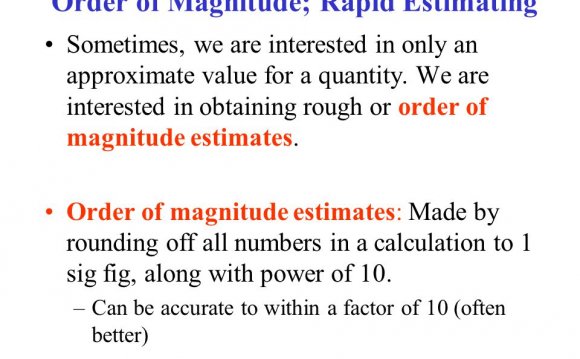
 We use order of magnitude (OOM) estimates at the beginning of a project. During the initiation phase, executives need information about how much the project will cost and how long it will take. They must decide if the project should go forward. They may also need to integrate this project with other projects the organization is considering. The data is vital for decision-making purposes and cost-benefit decisions. Unfortunately, this is the time when the project manager knows the least about what the project will entail. He doesn’t know what deliverables have to be produced, or how much work those deliverables will require. Project managers also have no idea how many team members will be available to do all this work. So the project manager is in no position to provide estimates that have any foundation in fact. Project Estimating Main Page
We use order of magnitude (OOM) estimates at the beginning of a project. During the initiation phase, executives need information about how much the project will cost and how long it will take. They must decide if the project should go forward. They may also need to integrate this project with other projects the organization is considering. The data is vital for decision-making purposes and cost-benefit decisions. Unfortunately, this is the time when the project manager knows the least about what the project will entail. He doesn’t know what deliverables have to be produced, or how much work those deliverables will require. Project managers also have no idea how many team members will be available to do all this work. So the project manager is in no position to provide estimates that have any foundation in fact. Project Estimating Main Page
The absence of data, however, does not prevent executives from demanding precise figures on a new project’s time and cost. Looking at the estimating situation at the beginning of a project from their perspective, we see why. They must approve and become accountable for the expenditure of many hours of work and other organization resources, including cash. From their perspective, it’s reasonable to understand the new project’s business benefit and how much of those resources it will consume.
Unfortunately, many project managers fall victim to the executive pressure and give estimates with no factual basis. Executives may say things like, “Use your project management experience to tell us how long this will take and what it will cost. If you’re worth your salt as a project manager you ought to be able to tell us the duration and budget you’ll need.”
This inevitably leads to blaming the project manager for finishing late and over budget.
Experience in project management, however, does not give you the ability to pull accurate numbers out of the sky. The one exception might be when you’re repeating the same project, like building new fast food stores in the same city. But when you don’t have data from similar completed projects, there is no way you can provide accurate data during the initiation phase.
Order of Magnitude Estimates Are Better Than Commitments You Can’t Keep
In this situation, order of magnitude estimates are the best tool for a project manager. With OOM estimates, the project manager is not providing a precise budget and completion date. He will be able to do later on. Now the project manager provides data along with information about the degree of uncertainty of the estimates. Order of magnitude estimates take the form of a project manager saying, “I’m 80% certain that the cost will be between $50, 000 and $100, 000. I’m 70% certain that we can be finished between 100 and 150 days.”
You’ve already decided that numbers like this will drive executives crazy; and you are right. accurate.But that’s not possible. The best we can do at this point is give them an estimate that reflects the lack of information. We do not give estimates with no factual basis; that is a losing strategy.
The only time we have 100% certainty of an estimate of cost or duration is on the last day of the project. The dynamic that project managers need to explain is that the certainty of the estimates will improve as we proceed through detailed planning and execution. As we learn more and more about the deliverables we have to produce, the amount of work it will take to produce the deliverables and the size of the project team we have available to do the work, the estimates get better. Our estimates at initiation may have a range of -25 to +75%. As we begin detailed project planning that range narrows and when the plan is approved, we may have a range of uncertainty that is plus or – 15%. As execution of the project proceeds the range of the estimates narrows all the way through closeout.
We’re going to express the order of magnitude estimates as a range to reflect the uncertainty. However, that doesn’t mean we’re going to toss out numbers with no basis in fact. For order of magnitude estimates, we usually use analogous estimating techniques to provide the raw data and then alter this historical data in two ways. First, we’ll adjust the historical data to reflect the differences between the current project were trying to estimate and the completed project. We might gather people with known expertise and ask them to assess the difference in complexity, intensity and difficulty of the current project and the historic one. They might come up with a 15% adjustment factor. This means the current project is 15% more difficult and will require that much additional time.
The second adjustment we would make is to apply our uncertainty percentages. As an example the -25% to +75% range we discussed above. So the numbers would look like this
Hours of Work
From the archives; ABC project actual 10, 400 hours of work
adjustment factor +15% n DEF one is harder than ABC
DEF project 11, 960 hours
adjustment to reflect uncertainty -25 to +75
8, 970 to 20, 930 hours range that you see
The project manager would present this information by saying something like this. “We’ve assembled our best experts and used actual data from the ABC project done two years ago. We asked our experts to look at the hours ABC took and reach consensus on the differences between this new project and the one we did several years ago. They concluded that the current one was 15% more difficult and would require that many more hours. Then I applied the uncertainty factors to reflect how little we know about the project this early in the effort. The combination of those two data sources gives us the range of hours that you see above.”
When the executives complain about the lack of precision the project manager can say no more than, “this is the best available information we have as of today. As we learn more during the planning effort I will be able to provide you with increasingly precise numbers but we will always be dealing with some uncertainty.”
When pressed by the executives for better data project manager can say nothing but, “you want credible numbers and at the present time I know so little about this project the trying to be more precise would be deceitful.”









